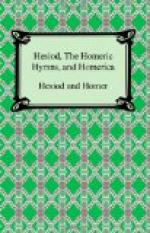(776 B.C.) downwards. This tradition cannot
be purely arbitrary. 2) The Cyclic poets (as we can
see from the abstract of Proclus) were careful not
to trespass upon ground already occupied by Homer.
Thus, when we find that in the “Returns”
all the prominent Greek heroes except Odysseus are
accounted for, we are forced to believe that the author
of this poem knew the “Odyssey” and judged
it unnecessary to deal in full with that hero’s
adventures. (12) In a word, the Cyclic poems are `written
round’ the “Iliad” and the “Odyssey”.
3) The general structure of these epics is clearly
imitative. As M.M. Croiset remark, the abusive
Thersites in the “Aethiopis” is clearly
copied from the Thersites of the “Iliad”;
in the same poem Antilochus, slain by Memnon and avenged
by Achilles, is obviously modelled on Patroclus. 4)
The geographical knowledge of a poem like the “Returns”
is far wider and more precise than that of the “Odyssey”.
5) Moreover, in the Cyclic poems epic is clearly
degenerating morally — if the expression
may be used. The chief greatness of the “Iliad”
is in the character of the heroes Achilles and Hector
rather than in the actual events which take place:
in the Cyclic writers facts rather than character
are the objects of interest, and events are so packed
together as to leave no space for any exhibition of
the play of moral forces. All these reasons
justify the view that the poems with which we now
have to deal were later than the “Iliad”
and “Odyssey”, and if we must recognize
the possibility of some conventionality in the received
dating, we may feel confident that it is at least
approximately just.
The earliest of the post-Homeric epics of Troy are
apparently the “Aethiopis” and the “Sack
of Ilium”, both ascribed to Arctinus of Miletus
who is said to have flourished in the first Olympiad
(776 B.C.). He set himself to finish the tale
of Troy, which, so far as events were concerned, had
been left half-told by Homer, by tracing the course
of events after the close of the “Iliad”.
The “Aethiopis” thus included the coming
of the Amazon Penthesilea to help the Trojans after
the fall of Hector and her death, the similar arrival
and fall of the Aethiopian Memnon, the death of Achilles
under the arrow of Paris, and the dispute between
Odysseus and Aias for the arms of Achilles. The
“Sack of Ilium” (13) as analysed by Proclus
was very similar to Vergil’s version in “Aeneid”
ii, comprising the episodes of the wooden horse, of
Laocoon, of Sinon, the return of the Achaeans from
Tenedos, the actual Sack of Troy, the division of
spoils and the burning of the city.
Lesches or Lescheos (as Pausanias calls him) of Pyrrha
or Mitylene is dated at about 660 B.C. In his
“Little Iliad” he undertook to elaborate
the “Sack” as related by Arctinus.
His work included the adjudgment of the arms of Achilles
to Odysseus, the madness of Aias, the bringing of
Philoctetes from Lemnos and his cure, the coming to
the war of Neoptolemus who slays Eurypylus, son of




